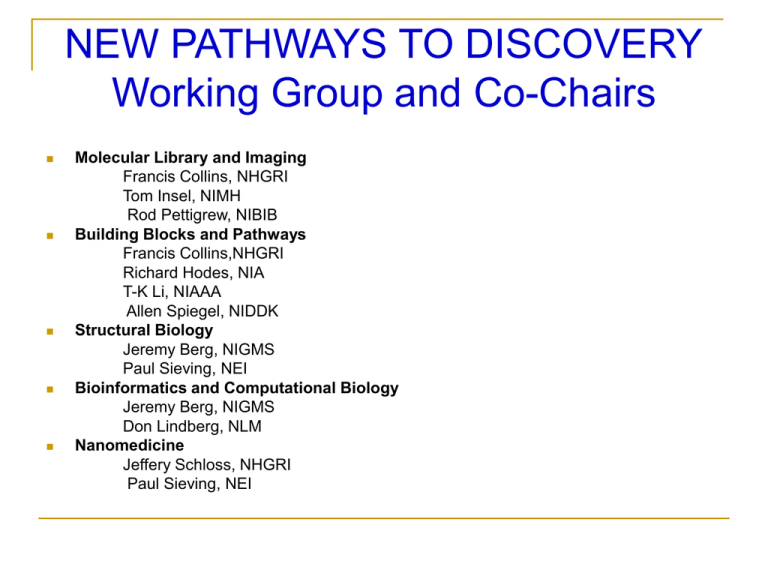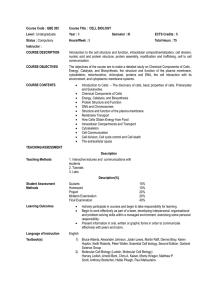Major Trends in Biomedical Research
advertisement

NEW PATHWAYS TO DISCOVERY Working Group and Co-Chairs Molecular Library and Imaging Francis Collins, NHGRI Tom Insel, NIMH Rod Pettigrew, NIBIB Building Blocks and Pathways Francis Collins,NHGRI Richard Hodes, NIA T-K Li, NIAAA Allen Spiegel, NIDDK Structural Biology Jeremy Berg, NIGMS Paul Sieving, NEI Bioinformatics and Computational Biology Jeremy Berg, NIGMS Don Lindberg, NLM Nanomedicine Jeffery Schloss, NHGRI Paul Sieving, NEI New Pathways to Discovery: The Molecular Libraries and Imaging Roadmap Initiative Francis S. Collins, M.D., Ph.D. New Pathways to Discovery Molecular Libraries and Imaging Building Blocks, Biological Pathways and Networks Structural Biology Bioinformatics and Computational Biology Nanomedicine Four recent developments make small molecules/chemical genomics initiative possible HGP Combinatorial Chemistry Availability of targets Compound Availability Availability of compounds Public sector screening and chemistry initiative Robotic Technology Availability of screening Molecular Libraries: Putting Chemistry to Work for Medicine Six national screening centers for small molecules Public database for “chemical genomics” Technology advances in combinatorial chemistry, robotics, virtual screening Collaborative Pipeline of a NIH Chemical Genomics Center Peer review Assay Customized Assay Compound Repository Investigator Screen Limited MedChem Cheminformatics, PubChem (NCBI) Probe List Probe picking, confirmation, secondary screens Molecular Libraries Repository & Screening Centers Small Molecule Repository Contract award in 2004 Screening Centers Intramural center: operational in 2004 Extramural centers: Request for Information issued 11/21/03 o received responses from universities and a few small biotechnology companies RFA release in Mar., receipt date summer, awards in spring 2005 Coordinating center for repository and screening centers o Contract award in 2005 Molecular Imaging Roadmap Components Development of high resolution probes for cellular imaging RFA issued in 2004 http://grants.nih.gov/grants/guide/rfa-files/RFA-RM-04001.html Development of an imaging probe database In process, with links to PubChem Core synthesis facility to produce imaging probes Efforts to establish an intramural facility are underway Potential Outcomes of Molecular Libraries & Imaging Probes Activities Development of research tools (molecular probes and novel assays) to facilitate studies of biology and pathophysiology Advances in biological research leading to the identification and validation of novel biological targets for therapeutics development Discovery of biological markers to monitor disease progression and to predict treatment response Structural Biology, Bioinformatics, Computational Biology and Nanomedicine Jeremy M. Berg, Ph.D. Structural Biology Initiative: Centers for Innovation in Membrane Protein Production Applications due March 11, 2004 $5M FY2004 Roadmap funding (~2 Centers, P50 Mechanism) Centers for Innovation in Membrane Protein Production Many physiologically and pharmaceutically important proteins are membrane proteins Few membrane proteins structures known All eukaryotic membrane protein structures determined to date have been from proteins derived from naturally rich sources Detergents and other agents required for solubilization and crystallization Development of methods for the production of structurally and functionally intact membrane proteins for subsequent structural studies 16 14 B.W. Matthews Ann. Rev. Phys. Chem. 27, 493 (1976) number of structures 12 water-soluble proteins 10 8 6 membrane proteins http://www.mpibp-frankfurt.pg.de/ michel/public/memprotstruct.html 4 2 0 1960 1970 1980 year 1990 2000 progress in membrane protein structure determinations parallels that of water-soluble proteins with a ~25 year offset Courtesy of Doug Rees, Caltech Structural Biology Roadmap Plans Wide range of structural biology programs throughout NIH (intramural and extramural) Synchrotron sources (NCRR, NCI, NIGMS) and NMR instrumentation (NCRR, NIGMS) supported Protein Structure Initiative-Network of Centers devoted to structural genomics Roadmap initiatives will be used to provide integration of these programs Bioinformatics and Computational Biology Initiative: National Centers for Biomedical Computing Applications received January 23, 2004 $12M FY2004 Roadmap funding (~4 Centers, U54 Mechanism) National Centers for Biomedical Computing Partnerships of: Computer scientists Biomedical computational scientists Experimental and clinical biomedical and behavioral researchers Focused on software rather than hardware Each National Center to have Driving Biological Projects Open source requirement Programs in preparation for partnerships between individual investigators and National Centers Nanomedicine Roadmap Initiative Nanomedicine describes the interface of biology and nanotechnology to understand and treat disease. Nanomedicine is a departure from the majority of nanotechnology research in that it integrates biomolecular processes toward developing therapies. Will need to develop new tools and a nanomedicine lexicon for shared use by engineers and biologists. Next Steps: Concept Development Awards in ’04; solicitation for Nanomedicine Development Centers in ‘05 2/2004




